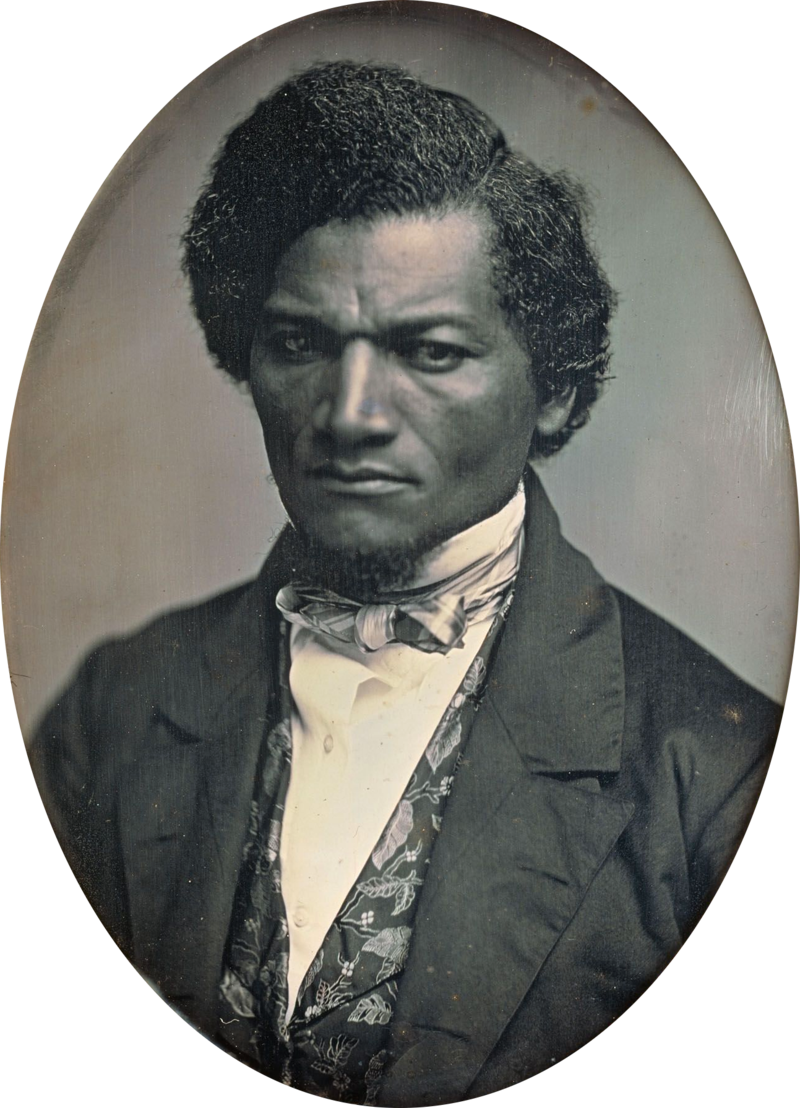What event marked the formal beginning of the women's rights movement in the U.S.?
¿Qué acontecimiento marcó el inicionformal del movimiento por los derechos de la mujer en Estados Unidos?
What is the Seneca Falls Convention?
¿Qué es la Convención de Seneca Falls?
What was the goal of the abolition movement?
¿Cuál era el objetivo del movimiento abolicionista?
To end slavery in the United States.
Acabar con la esclavitud en Estados Unidos.
What was the goal of the temperance movement?
¿Cuál era el objetivo del movimiento antialcohólico?
To reduce or eliminate alcohol consumption.
Reducir o eliminar el consumo de alcohol.
Who is this man, and what reform movement is he known for?
¿Quién es este hombre y por qué movimiento reformista es conocido? 
Who is the abolitionist, Frederick Douglass.
¿Quién es el abolicionista, Frederick Douglass.
Who was Susan B. Anthony?
¿Quién era Susan B. Anthony?
Who is one of the leaders of the Women's Rights Movement?
¿Quién es una de las líderes del Movimiento por los Derechos de la Mujer?
Who was the main author of the Declaration of Sentiments and a leader at the Seneca Falls Convention of 1848?
¿Quién fue el principal autor de la Declaración de Sentimientos y uno de los líderes de la Convención de Seneca Falls de 1848?
Who is Elizabeth Cady Stanton?
Name one famous conductor of the Underground Railroad.
Nombra a un famoso conductor del Ferrocarril Subterráneo.
Who is Harriet Tubman?
What was the goal of the Second Great Awakening?
¿Cuál era el objetivo del Segundo Gran Despertar?
Religious Revivals in the Burned Over District in NYS. (Can name a Christian group if necessary)
Revivals Religiosos en el Distrito de Burned Over en NYS. (Puede nombrar un grupo cristiano si es necesario)
What direction were freedom seekers going in?
¿En qué dirección iban los buscadores de libertad?
What is North?
¿Qué es el Norte?
What is a major difference between the geography and economy of the North and the South in the 1800s?
¿Cuál es la principal diferencia entre la geografía y la economía del Norte y del Sur en el siglo XIX?
The South is known for plantations, and the North is known for industrialization and factories.
El Sur es conocido por las plantaciones, y el Norte por la industrialización y las fábricas.
Name one famous African American who supported women's rights and attended the Seneca Falls Convention.
Nombre a un afroamericano famoso que apoyara los derechos de la mujer y asistiera a la Convención de Seneca Falls.
Who is Frederick Douglass?
What was the Underground Railroad?
¿Qué era el Ferrocarril Subterráneo?
A secret network that helped enslaved people escape to freedom.
Name one reform movement that grew out of the Second Great Awakening.
Nombra un movimiento reformista que surgió del Segundo Gran Despertar.
Possible answers: temperance, abolition, education, women’s rights.
Posibles respuestas: templanza, abolición, educación, derechos de la mujer.
What countries were freedom seekers escaping to on the Underground Railroad?
¿A qué países escapaban los buscadores de libertad en el Ferrocarril Subterráneo?
What is Canada or Mexico?
¿Qué es Canadá o México?
In what year did the United States officially ban the international slave trade, making it illegal to import enslaved people from other countries?
¿En qué año Estados Unidos prohibió oficialmente el comercio internacional de esclavos, declarando ilegal la importación de personas esclavizadas de otros países?
What is 1808?
Which document did Elizabeth Cady Stanton model her “Declaration of Sentiments” after?
¿En qué documento inspiró Elizabeth Cady Stanton su «Declaración de sentimientos»?
What is the Declaration of Independence?
Which 1852 book by Harriet Beecher Stowe exposed the horrors of slavery and increased anti-slavery support in the North?
¿Qué libro de 1852 escrito por Harriet Beecher Stowe expuso los horrores de la esclavitud y aumentó el apoyo antiesclavista en el Norte?
What is Uncle Tom’s Cabin?
What does the term “suffrage” mean?
¿Qué significa el término «sufragio»?
What is the right to vote?
¿Qué es el derecho de voto?
What region of New York State are majority of the religious Revivals in the Burned Over District?
¿En qué región del Estado de Nueva York se encuentran la mayoría de los religiosos del distrito de Burned Over?
What is Central New York, Western New York, or the Finger Lakes region?
¿Qué es Nueva York Central, Nueva York Occidental o la región de los Finger Lakes?
What did Abolitionist, William Lloyd Garrison, write?
¿Qué escribió el abolicionista William Lloyd Garrison?
The newspaper, The Liberator.
El periódico, El Libertador.
In what year did women finally gain the right to vote in the United States?
¿En qué año obtuvieron finalmente las mujeres el derecho al voto en Estados Unidos?
What is 1920?
What invention increased the demand for enslaved labor in the South during the 1800s?
¿Qué invento aumentó la demanda de mano de obra esclava en el Sur durante el siglo XIX?
What is the cotton gin?
¿Qué es la desmotadora de algodón?
What group in the Second Great Awakening was founded in Palmyra, NY by leader Joseph Smith?
¿Qué grupo del Segundo Gran Despertar fue fundado en Palmyra, Nueva York, por el líder Joseph Smith?
What is Mormons?
What reform movement does this image depict?
¿Qué movimiento reformista representa esta imagen?

What is the Temperance Movement?
¿Qué es el movimiento antialcohólico?
What was the Fugitive Slave Act?
¿Qué era la Ley del Esclavo Fugitivo?
To require that escaped enslaved people be returned to their enslavers, even if they were found in free states.
Exigir que las personas esclavizadas fugadas fueran devueltas a sus esclavizadores, incluso si se encontraban en estados libres.